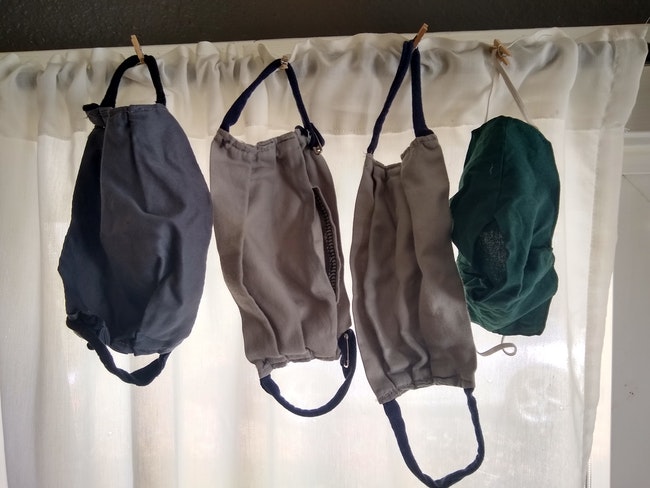 Face masks. Photo: Chas Hundley
Face masks. Photo: Chas Hundley
A number of new measures will begin on Wednesday, November 18 aimed at controlling the spread of COVID-19, in an effort to slow the spread of COVID-19 before Oregon’s hospital system becomes overwhelmed.
Governor Kate Brown is calling the latest measures a “Two-Week Freeze” and unlike the county-by-county “Two-Week Pause,” the new measures are statewide.
“Whether we like it or not, we’re about to face what might be the roughest days of the pandemic,” Brown said during a press conference on Friday afternoon. “If we want to give Oregonians a fighting chance, we must take further measures to flatten the curve now.”
Under the regulations, which will begin Nov. 18 and run through at least December 2, a number of actions, targeted largely at businesses, will take effect.
They include:
— Limiting social get-togethers in or out-of-doors to no more than six individuals total from no more than two households.
— Limiting churches and other faith-based organizations to 25 or less people indoors or 50 people outdoors.
— Returning bars and restaurants to take-out and delivery only
— Closing gyms and other fitness organizations
— Closing indoor and outdoor recreational facilities, such as pools and sports courts, museums, indoor entertainment facilities such as movie theaters, and closing zoos, gardens, aquariums, and more.
— Limiting grocery stores, pharmacies, retail stores, and malls to no more than 75% capacity and encouraging curbside pick-up
— Closing venues that host indoor and outdoor events
— Requiring businesses to mandate work-from-home measures when possible, and closing offices to the general public.
— Halting indoor visits at long-term care facilities.
Some activities and facilities will be allowed to continue, including personal services such as barbershops, hair salons, non-medical massage therapy, outdoor recreation and sports at parks and some outdoor spaces, government-maintained parks and playgrounds, childcare and youth programs, schools permitted to operate under current COVID-19 measures, and current Division 1 and professional athletics already exempted.
The Oregon Health Authority plans to issue industry-specific guidance within the next week to address what is and is not allowed for those businesses impacted by the new measures.
“COVID-19 is spreading at an escalating and alarming rate last week,” Dr. Dean Sidelinger, OHA State Health Officer said during Friday’s press conference, “For the week ending Sunday, Nov. 8, we reported 5,177 new cases of COVID-19 – a 46% increase over the previous week’s record high. I am saddened to tell you the virus claimed 42 lives last week, a record high,” he said.
“What’s causing this surge in community spread? Social gatherings,” Sidelinger noted, adding that the OHA had traced a significant proportion of COVID-19 cases to social gatherings where Oregon residents ignored state health precautions, gathering indoors without masks and without regard to social distancing.
A coordinated travel advisory in Oregon, Washington, and California urging state residents to avoid travel and to quarantine for 14 days after travel was enacted Friday morning by each state’s respective governor.
The move comes as COVID-19 cases in Oregon and the U.S. have risen dramatically, and it comes in advance of Thanksgiving Day, a traditionally high travel period with families flying and driving to different states for holiday festivities.
“COVID-19 does not stop at state lines. As hospitals across the West are stretched to capacity, we must take steps to ensure travelers are not bringing this disease home with them,” said Oregon Governor Kate Brown. “If you do not need to travel, you shouldn’t. This will be hard, especially with Thanksgiving around the corner. But the best way to keep your family safe is to stay close to home.”
Brown’s sentiments were echoed by California Governor Gavin Newsom and Washington Governor Jay Inslee.
The travel advisory — which is an advisory, not an actual law or prohibition on travel — says that people, including Oregon residents, should self-quarantine for 14 days upon arriving or returning to Oregon, and limit their interactions to those within their immediate household.
The travel advisory does not apply to those traveling for “essential” purposes, Brown said, defining such essential travel as travel for the purposes of “work and study, critical infrastructure support, economic services and supply chains, health, immediate medical care, and safety and security.”
The advisory also says that Oregonians should simply avoid crossing state or country borders, and stay home or within their own region.
However, it’s not clear how effective such travel advisories will be, with the state also noting significant community spread already present within Oregon.

Chas Hundley is the editor of the Banks Post and sister news publications the Gales Creek Journal and the Salmonberry Magazine. He grew up in Gales Creek and has a cat.




